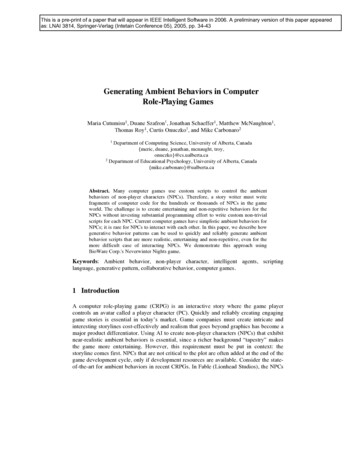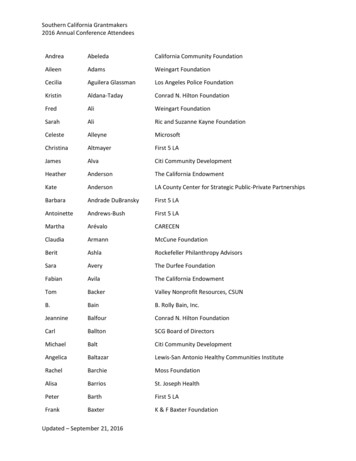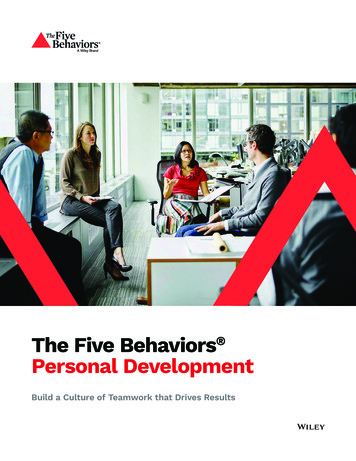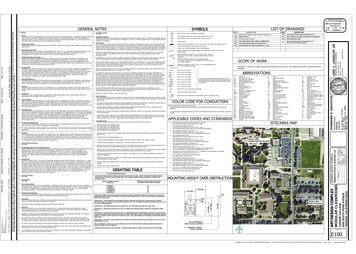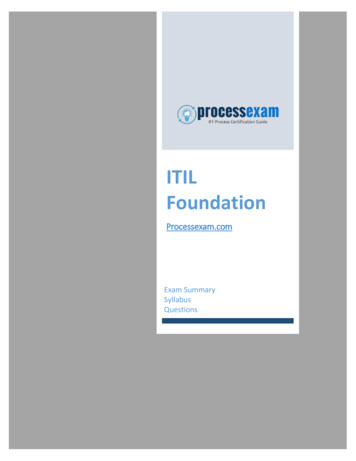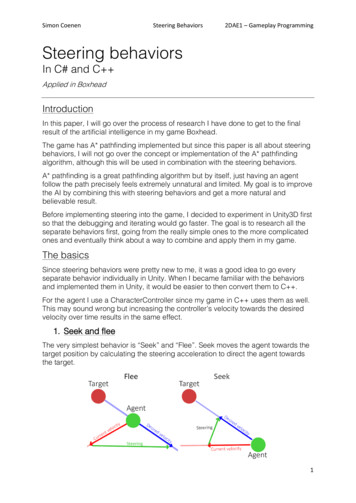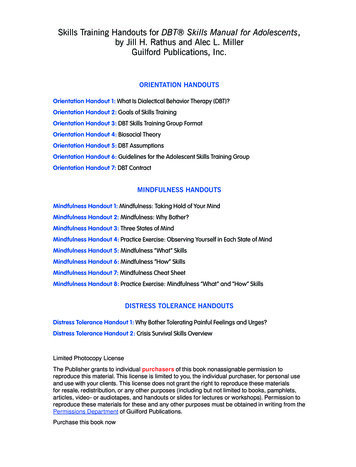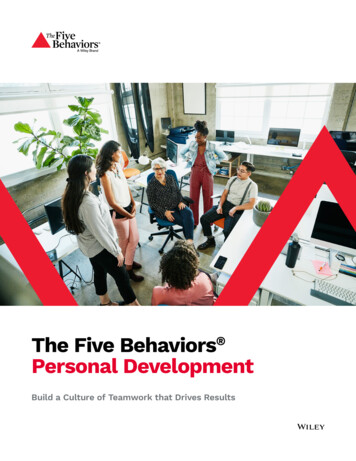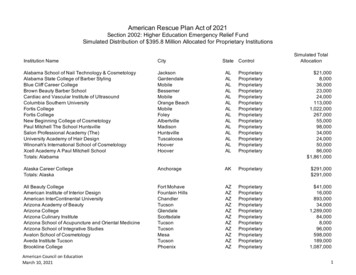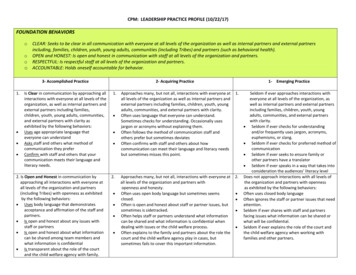
Transcription
CPM: LEADERSHIP PRACTICE PROFILE (10/22/17)FOUNDATION BEHAVIORSoCLEAR: Seeks to be clear in all communication with everyone at all levels of the organization as well as internal partners and external partnersincluding, families, children, youth, young adults, communities (including Tribes) and partners (such as behavioral health).o OPEN and HONEST: Is open and honest in communication with staff at all levels of the organization and partners.o RESPECTFUL: Is respectful staff at all levels of the organization and partners.o ACCOUNTABLE: Holds oneself accountable for behavior.3- Accomplished Practice1. Is Clear in communication by approaching allinteractions with everyone at all levels of theorganization, as well as internal partners andexternal partners including families,children, youth, young adults, communities,and external partners with clarity asexhibited by the following behaviors:Uses age appropriate language thateveryone can understandAsks staff and others what method ofcommunication they preferConfirm with staff and others that yourcommunication meets their language andliteracy needs.2. Is Open and Honest in communication byapproaching all interactions with everyone atall levels of the organization and partners(including Tribes) with openness as exhibitedby the following behaviors: Uses body language that demonstratesacceptance and affirmation of the staff andpartners. Is open and honest about any issues withstaff or partners Is open and honest about what informationcan be shared among team members andwhat information is confidential Is transparent about the role of the courtand the child welfare agency with family.2- Acquiring Practice1. 2. 1- Emerging PracticeApproaches many, but not all, interactions with everyone atall levels of the organization as well as internal partners andexternal partners including families, children, youth, youngadults, communities, and external partners with clarity.Often uses language that everyone can understand.Sometimes checks for understanding. Occasionally usesjargon or acronyms without explaining them.Often follows the method of communication staff andothers prefer but sometimes deviatesOften confirms with staff and others about howcommunication can meet their language and literacy needsbut sometimes misses this point.1.Approaches many, but not all, interactions with everyone atall levels of the organization and partners withopenness and honesty.Often uses open body language but sometimes seemsclosed.Often is open and honest about staff or partner issues, butsometimes is sidetracked.Often helps staff or partners understand what informationcan be shared and what information is confidential whendealing with issues or the child welfare process.Often explains to the family and partners about the role thecourt and the child welfare agency play in cases, butsometimes fails to cover this important information.2. Seldom if ever approaches interactions witheveryone at all levels of the organization, aswell as internal partners and external partnersincluding families, children, youth, youngadults, communities, and external partnerswith clarity. Seldom if ever checks for understandingand/or frequently uses jargon, acronyms,euphemisms, or slang. Seldom if ever checks for preferred method ofcommunication Seldom if ever seeks to ensure family orother partners have a translator Seldom if ever speaks in a way that takes intoconsideration the audiences’ literacy levelDoes not approach interactions with all levels ofthe organization and partners with opennessas exhibited by the following behaviors:Often uses closed body languageOften ignores the staff or partner issues that needattention.Seldom if ever shares with staff and partnersfacing issues what information can be shared orwhat will be confidential.Seldom if ever explains the role of the court andthe child welfare agency when working withfamilies and other partners.
3-Accomplished Practice2-Acquiring Practice3. Is Respectful towards everyone at all levels ofthe organization and partners. Asks people how they prefer to be addressed. Addresses individuals consistently by thename or title and pronouns they request inperson and in writing. Especially wheninteracting with Tribal leaders and members. Responds to questions and describes thesituation honestly, providing relevant factsand information about the system. Makes clear statements about whatinformation or action is being requested ofstaff. Facilitates a dialogue regarding how therequested information and actions will affectthe situation and support the staff member orfamily. Shows deference to Tribal leadership andtheir titles in written and verbalcommunication.3.4. Is Accountable in one’s behavior towardseveryone at all levels of the organization andpartners. Models accountability and trust by doingwhat you say you’re going to do. Responsive to staff and partners byreturning calls, texts, and emails within 24business hours. Responsible by being on time forappointments and asking for reports in toensure staff have time to complete suchreports. Follows ICWA and other federal and statelaws.4. Is generally accountable in behavior towards everyone at alllevels of the organization and partners. Often models accountability and trust by doing what you sayyou’re going to do, but sometimes does not follow throughwith promises. Often responsive to staff and partners by returning calls,texts, and emails within 24 business hours but sometimes aresponse occurs out of that timeframe. Often responsible by being on time for both appointmentsand requests for but sometimes you are late. Often follow ICWA and other federal and state laws butsometimes make mistakes. Is generally respectful towards everyone at all levels of theorganization and partners but does so inconsistently or withmoderate success.Often asks people how they prefer to be addressed, butsometimes forgets to ask.Often addresses individuals by the name or title and pronounsthey request in person and in writing, but sometimes makes amistake with a mispronunciation, incorrect abbreviation orforgets the preferred name, title or pronoun altogether.Often shows deference to Tribal leadership and their titles inwritten and verbal communication but sometimes is not asdeference as the leader desires them to be.1-Emerging Practice3. Seldom behaves respectfully towards everyoneat all levels of the organization and partners.Seldom if ever inquires as to how people prefer tobe addressed.Seldom if ever addresses individuals the way theywant to be addressed.Seldom if ever uses the name, title or pronounsthe person desires or has requested.Seldom if ever shows appropriate deference toTribal leadership, nor do they use their titles inwritten and verbal communication.4. Seldom holds self accountable in behaviortowards everyone at all levels of the organization,and partners. Seldom if ever models accountability and trust bydoing what you say you’re going to do. Seldom if ever is responsive to staff and partnersby returning calls, texts, and emails within 24business hours. Seldom if ever is responsible by being on time forboth appointments and requesting reports. Seldom if ever follows ICWA and other federal andstate laws.
LEADERSHIP ENGAGEMENT BEHAVIORSooooCREATE A LEARNING ENVIRONMENT –ENGAGE STAFF IN IMPLEMENTATION AND SYSTEM IMPROVEMENT –DEMONSTRATE CARINGRECOGNIZE STAFF STRENGTHS AND SUCCESSES-3-Accomplished Practice5. Creates a learning environment – Demonstrates commitment to theprofessional development of staff byproviding opportunities for staff togain new knowledge and skillsthrough multiple strategies (e.g.training, coaching, and leadershipopportunities) – particularly as itrelates to the CPM Creates a learning environment inwhich mistakes are seen asopportunities to learn and grow. Fosters a culture of thinking aboutwork, trying new things and newapproaches for everyone that willmake the agency more efficient andeffective. Pauses and take time to use thepractice model to guide response andinteraction even in times of crisis.6. Engages staff in implementation and systemimprovement. Participates with staff onimplementation and identifies whatyou are doing to support and sustainthe CPM. Managers create andparticipate on implementationteam(s) for CPM. Directors establishdivision CPM goals and communicatethem at every opportunity. Directorsestablish and maintain regular andfrequent communication between theleadership team and theimplementation team. Directorsinclude staff in creation of the visionfor CPM and explain how staff rolespay a key part in creation of the2-Acquiring Practice1-Emerging Practice5. Generally creates a learning environment –5. Seldom if ever creates a learning environment – Often demonstrates commitment to professional Seldom if ever demonstrates commitment todevelopment of staff by providing opportunities forprofessional development of staff by providingstaff to gain new knowledge and skills. Sometimesopportunities for staff to gain new knowledgefocuses too much on training and not enough onand skills. Minimizes the time staff spend incoaching and leadership opportunities.training and does not offer coaching orleadership opportunities. Often creates a learning environment in which mistakesare seen as opportunities to learn and grow but Seldom if ever creates a learning environment insometimes punishes mistakes.which mistakes are seen as opportunities tolearn and grow but instead punishes mistakes. Often fosters a culture of thinking about work, tryingnew things and new approaches for everyone that will Seldom if ever fosters a culture of thinkingmake the agency more efficient and effective butabout work, trying new things and newsometimes relies on the status quo.approaches for everyone that will make theagency more efficient and effective but instead Often pauses and takes time to use the practice modelrelies on the status quo.to guide response and interaction even in times of crisisbut sometimes get caught up in the crisis. Seldom if ever pauses and takes time to use thepractice model to guide response andinteraction especially in times of crisis.6. Often engages staff in implementation and systemimprovement. Often participates with staff on implementation andidentifies what you are doing to support and sustainthe CPM. Sometimes engages managers, directors andsupervisors in establishing goals for CPM,communicating between leadership and theimplementation team(s) and creating vision for thestaff. Often uses positive motivation, encouragement andrecognition of strengths to show support of staffimplementation efforts but sometimes doesn’t focuson strengths. Often engages staff and managers at all levels toidentify ways to improve system efficiency and removebarriers for staff.6. Seldom if ever engages staff in implementation andsystem improvement. Seldom if ever participates with staff onimplementation and identifies what you aredoing to support and sustain the CPM. Does notengage managers, directors and supervisors inestablishing goals for CPM, communicatingbetween leadership and the implementationteam(s) and creating vision for the staff. Seldom if ever uses positive motivation,encouragement and recognition of strengths toshow support of staff implementation efforts. Seldom if ever engages staff and managers atall levels to identify ways to improve systemefficiency and remove barriers for staff.
vision.Supervisors participate on the CPMimplementation team. Supervisorsestablish unit CPM goals andcommunicate them in unit meetingsand individual supervision. Uses positive motivation,encouragement and recognition ofstrengths to show support of staffimplementation efforts. Engages staff and managers at alllevels to identify ways to improvesystem efficiency and remove barriersfor staff.7. Demonstrate caring Demonstrate listening and care aboutthe thoughts and experiences of staffand stakeholders (children, families,community members, and Tribes) asthey implement and sustain the CPMby establishing feedback loops andregular mechanisms to reportprogress and outcomes. Communicate hope andunderstanding by listening to staffchallenges and engaging in solutionfocused strategies to work together tosolve problems. Show compassion and providesupport and encouragement bylistening to staff at all levels in theorganization to hear their successes,concerns/worries and ideas aboutimplementing, supporting, andsustaining the model. Supervisorsprovide a mechanism for unit staff tovoice their challenges and successeswith CPM and share those challengesand success with managers anddirectors.7. Often demonstrates caring Often demonstrates listening and care about thethoughts and experiences of staff and stakeholders(children, families, community members, and Tribes)as they implement and sustain the CPM. Sometimesestablish feedback loops and regular mechanisms toreport progress and outcomes. Often communicates hope and understanding bylistening to staff challenges and engaging in solutionfocused strategies to work together to solve problems. Often shows compassion and provides support andencouragement by listening to staff at all levels in theorganization to hear their successes, concerns/worriesand ideas about implementing, supporting, andsustaining the model. Supervisors often provide amechanism for unit staff to voice their challenges andsuccesses with CPM and share those challenges andsuccess with managers and directors.7. Seldom if ever demonstrates caring Seldom if ever demonstrates listening or careabout the thoughts and experiences of staffand stakeholders (children, families, communitymembers, and Tribes) as they implement andsustain the CPM. Does not establish feedbackloops and regular mechanisms to reportprogress and outcomes. Seldom if ever communicates hope orunderstanding. Does not listen to staffchallenges and doesn’t engage in solutionfocused strategies to work together to solveproblems. Seldom if ever shows compassion nor providessupport and encouragement. Does not listen tostaff at all levels in the organization to heartheir successes, concerns/worries and ideasabout implementing, supporting, and sustainingthe model. Supervisors seldom provide amechanism for unit staff to voice theirchallenges and successes with CPM nor arethey able to share those challenges and successwith managers and directors.
8. Recognizes staff strengths and success Create regular opportunities to affirmagency organizational strengths andthe efforts of staff and partners intheir daily work Foster leadership by staff at all levels,helping them recognize and gainconfidence in their strengths.Supervisors foster leadership of staff,helping them recognize and gainconfidence in their strengths, byproviding opportunities in unitmeetings to share some of thesuccessful outcomes of their caseworkand the casework skills they utilized.Managers foster leadership of staff,helping them recognize and gainconfidence in their strengths byproviding opportunities to take onlead assignments that demonstratetheir skills and abilities such asmeeting with community stakeholdersto describe CPM. Directors fosterleadership of staff, helping themrecognize and gain confidence in theirstrengths by providing opportunitiesto share their experience and mentornew managers.8. Often recognizes staff strengths and success Often creates regular opportunities to affirm agencyorganizational strengths and the efforts of staff andpartners in their daily work but sometimes missesstrengths. Often fosters leadership by staff at all levels, helpingthem recognize and gain confidence in their strengthsbut sometimes does not ensure that - Supervisorsfoster leadership of staff, helping them recognize andgain confidence in their strengths, by providingopportunities in unit meetings to share some of thesuccessful outcomes of their casework and thecasework skills they utilized. Managers fosterleadership of staff, helping them recognize and gainconfidence in their strengths by providingopportunities to take on lead assignments thatdemonstrate their skills and abilities such as meetingwith community stakeholders to describe CPM.Directors foster leadership of staff, helping themrecognize and gain confidence in their strengths byproviding opportunities to share their experience andmentor new managers.8. Seldom if ever recognizes staff strengths and success Seldom if ever creates regular opportunities toaffirm agency organizational strengths and theefforts of staff and partners in their daily work. Seldom if ever fosters leadership by staff at alllevels, helping them recognize and gainconfidence in their strengths- does not ensurethat - Supervisors foster leadership of staff,helping them recognize and gain confidence intheir strengths, by providing opportunities inunit meetings to share some of the successfuloutcomes of their casework and the caseworkskills they utilized. Managers foster leadershipof staff, helping them recognize and gainconfidence in their strengths by providingopportunities to take on lead assignments thatdemonstrate their skills and abilities such asmeeting with community stakeholders todescribe CPM. Directors foster leadership ofstaff, helping them recognize and gainconfidence in their strengths by providingopportunities to share their experience andmentor new managers.
INQUIRY/EXPLORATION BEHAVIORS OF LEADERSHIPo9. SEEKS FEEDBACK3-Accomplished PracticeSeeks feedbackMeets regularly with staff andstakeholders (children, families,community members, and Tribes) tounderstand their perspectives, developconsensus and create a path forwardthat is sensitive to the varied needs andconcerns of all parties.Regularly elicits feedback from staff andstakeholders (children, families,community members, and Tribes) bymeans of focus groups, surveys andcommunity meetings. Supervisorsexplore with staff any concerns theymight have with the CPM in their childwelfare role. Supervisors explore withstaff barriers and solutions toimplementing and sustaining themodel. Managers keep track of andacknowledge barriers and challengesimpacting the division and betransparent with staff about what canbe accomplished and what cannot.Managers explore with supervisors anddirectors barriers and solutions toimplementing and sustaining themodel. Directors keep track of andacknowledge barriers and challengesimpacting the organization and betransparent with staff and partnersabout what can be accomplished andwhat cannot.Seeks out and invites in input from staffin the organization. Supervisors holdregular supervision meetings with staffto review casework for fidelity to theCPM and to actively seek input anddevelop solutions for issues that impactthe social worker’s ability to workeffectively with children youth and2-Acquiring Practice9. Often seeks feedback Often meets with staff and stakeholders (children, families,community members, and Tribes) to understand theirperspectives, develop consensus and create a path forwardthat is sensitive to the varied needs and concerns of all partiesbut sometimes gets too busy and misses these opportunities. Often elicits feedback from staff and stakeholders (children,families, community members, and Tribes) by means of focusgroups, surveys and community meetings. But does not alwaysencourage: Supervisors explore with staff any concerns theymight have with the CPM in their child welfare role.Supervisors explore with staff barriers and solutions toimplementing and sustaining the model. Managers keep trackof and acknowledge barriers and challenges impacting thedivision and be transparent with staff about what can beaccomplished and what cannot. Managers explore withsupervisors and directors barriers and solutions toimplementing and sustaining the model. Directors keep trackof and acknowledge barriers and challenges impacting theorganization and be transparent with staff and partners aboutwhat can be accomplished and what cannot. Often seeks out and invites in input from staff in theorganization. But does not always ensure that: Supervisorshold regular supervision meetings with staff to reviewcasework for fidelity to the CPM and to actively seek input anddevelop solutions for issues that impact the social worker’sability to work effectively with children youth and families.Managers hold regular supervision meetings with supervisorsto review their unit’s work and to actively seek input anddevelop solutions for issues that impact the ability of their unitto work effectively within the Division and with children, youthand families. Directors hold regular supervision meetings withmanagers to review the work of their divisions and to activelyseek input and develop solutions for issues that impact theability of their division to effectively deliver services tochildren, youth and families consistent with the CPM.1-Emerging Practice9. Seldom if ever seeks feedback Seldom if ever meets with staff and stakeholders(children, families, community members, and Tribes)to understand their perspectives, develop consensusand create a path forward that is sensitive to thevaried needs and concerns of all parties. Seldom if ever elicits feedback from staff andstakeholders (children, families, community members,and Tribes) by means of focus groups, surveys andcommunity meetings. Does not encourage:Supervisors explore with staff any concerns theymight have with the CPM in their child welfare role.Supervisors explore with staff barriers and solutions toimplementing and sustaining the model. Managerskeep track of and acknowledge barriers andchallenges impacting the division and be transparentwith staff about what can be accomplished and whatcannot. Managers explore with supervisors anddirectors barriers and solutions to implementing andsustaining the model. Directors keep track of andacknowledge barriers and challenges impacting theorganization and be transparent with staff andpartners about what can be accomplished. Seldom if ever seeks out and invites in input from staffin the organization. Does not always ensure that:Supervisors hold regular supervision meetings withstaff to review casework for fidelity to the CPM and toactively seek input and develop solutions for issuesthat impact the social worker’s ability to workeffectively with children youth and families. Managershold regular supervision meetings with supervisors toreview their unit’s work and to actively seek input anddevelop solutions for issues that impact the ability oftheir unit to work effectively within the Division andwith children, youth and families. Directors holdregular supervision meetings with managers to reviewthe work of their divisions and to actively seek inputand develop solutions for issues that impact the abilityof their division to effectively deliver services tochildren, youth and families consistent with the CPM.
families. Managers hold regularsupervision meetings with supervisorsto review their unit’s work and toactively seek input and developsolutions for issues that impact theability of their unit to work effectivelywithin the Division and with children,youth and families. Directors holdregular supervision meetings withmanagers to review the work of theirdivisions and to actively seek input anddevelop solutions for issues that impactthe ability of their division to effectivelydeliver services to children, youth andfamilies consistent with the CPM.
ADVOCACY BEHAVIORS FOR LEADERSHIPooPROMOTES ADVOCACYADVOCATES FOR RESOURCES3-Accomplished Practice10. Promotes advocacy: Provides frequent and regular opportunitiesfor Tribes, agency partners, staff, youth,families and caregivers to share their voice.11. Advocates for resources: Advocates for the resources needed tosupport and develop staff. Supervisorsprovide information to managementabout gaps in staffing and necessaryresources needed to implement CPM.Managers provide information toexecutive leadership regarding staffinggaps to support requests for additionalresources to fill the gaps. Directorsbecome champions for the CPM byadvocating for resources to supportCPM practices and working to establishpolicies and practices that eliminatebarriers for staff. Directors inpartnership with the implementationteam, review planning goals andtimeframes for training, coaching policy,and practice change so thatexpectations for staff are clear andrealistic. Advocates for the resources needed toprovide effective, relevant, culturallyresponsive services for families.Supervisors provide information aboutgaps in services and resources neededto implement CPM. Managers activelyseek information about gaps in servicesfor families and advocate to executive2-Acquiring Practice10. Often promotes advocacy: Often provides frequent and regular opportunities forTribes, agency partners, staff, youth, families andcaregivers to share their voice but sometimes excludestheir suggestions11. Often advocates for resources: Often advocates for the resources needed to supportand develop staff. But does not always encourage.Supervisors to provide information to managementabout gaps in staffing and necessary resources neededto implement CPM. Managers to provide information toexecutive leadership regarding staffing gaps to supportrequests for additional resources to fill the gaps.Directors to become champions for the CPM byadvocating for resources to support CPM practices andworking to establish policies and practices thateliminate barriers for staff. Directors in partnership withthe implementation team, review planning goals andtimeframes for training, coaching policy, and practicechange so that expectations for staff are clear andrealistic. Often advocates for the resources needed to provideeffective, relevant, culturally responsive services forfamilies. But does not always encourage Supervisors toprovide information about gaps in services andresources needed to implement CPM. Managers toactively seek information about gaps in services forfamilies and advocate to executive leadership forresources. Managers to develop policies and processesthat facilitate and promote teaming across divisions,across agencies, and with external partners. Directors toensure that all contracts are supportive of CPMpractices and aligned with the CPM.1-Emerging Practice10. Seldom if ever promotes advocacy: Seldom if ever provides opportunities forTribes, agency partners, staff, youth, familiesand caregivers to share their voice.11. Seldom if ever advocates for resources: Seldom if ever advocates for the resourcesneeded to support and develop staff. Doesnot encourage. Supervisors to provideinformation to management about gaps instaffing and necessary resources needed toimplement CPM. Managers to provideinformation to executive leadershipregarding staffing gaps to support requestsfor additional resources to fill the gaps.Directors to become champions for the CPMby advocating for resources to support CPMpractices and working to establish policiesand practices that eliminate barriers for staff.Directors in partnership with theimplementation team, review planning goalsand timeframes for training, coaching policy,and practice change so that expectations forstaff are clear and realistic. Seldom if ever advocates for the resourcesneeded to provide effective, relevant,culturally responsive services for families.Does not encourage Supervisors to provideinformation about gaps in services andresources needed to implement CPM.Managers to actively seek information aboutgaps in services for families and advocate toexecutive leadership for resources. Managersto develop policies and processes that
leadership for resources. Managersdevelop policies and processes thatfacilitate and promote teaming acrossdivisions, across agencies, and withexternal partners. Directors ensure thatall contracts are supportive of CPMpractices and aligned with the CPM.facilitate and promote teaming acrossdivisions, across agencies, and with externalpartners. Directors to ensure that allcontracts are supportive of CPM practicesand aligned with the CPM.
TEAMING BEHAVIORS FOR LEADERSHIPoooBUILDS PARTNERSHIPS- Develop partnerships with effective community-based service providers with cultural connections to families receiving servicesfrom the CWS agencyWORKS COLLABORATIVELY WITH COMMUNITY PARTNERS- Works collaboratively with community partners to create better ways for children, youth,young adults and families to access servicesMODEL TEAMING3-Accomplished Practice12. Develops partnerships with effectivecommunity-based service providers with culturalconnections to families receiving services fromthe CWS agency Supervisor Gather information from staffand families about the services available inthe community and work to identify newpotential service partners. Manager Under the direction of the childwelfare director, sustain partnerships witheffective community-based service providerswith cultural connections to familiesreceiving services from the CWS agency. Managers; Develop partnerships withstakeholders to support CPMimplementation. Directors Actively establish and facilitatecommunity partnerships by initiating,attending, and participating in inter-agencycollaborations to implement, support andsustain the CPM. Directors Meet with the Court to develop anunderstanding of CPM and identify actionsthe Court can take to supportimplementation and use of the CPM. Directors: Actively establish and facilitatepartnerships with other Divisions in theAgency (such as Staff Development andFiscal) to implement, support, and sustainthe CPM.2-Acquiring Practice12. Generally, develops partnerships with effective communitybased service providers with cultural connections to familiesreceiving services from the CWS agency Supervisor Often gathers information from staff and familiesabout the services available in the community and oftenworks to identify new potential service partners butsometimes l
Tribal leadership, nor do they use their titles in Makes clear statements about what information or action is being requested of staff. Facilitates a dialogue regarding how the requested information and actions will affect the situation and support the staff member or family. Shows deference to Tribal leadership and

